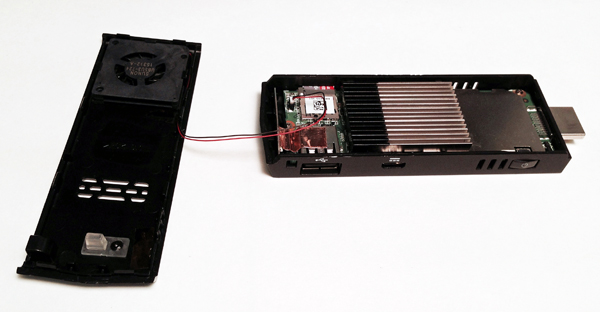Intel Compute Stick Review
At CES 2015, Intel quietly announced its upcoming Bay Trail-based Compute Stick. Last week we got to check out a sample unit up close and personal.
Why you can trust Tom's Hardware
Internal Features
Warning
The Compute Stick is not meant to be end-user serviceable. Open it at your own risk.
From Intel's Bay Trail family of SoCs, the Compute Stick sports Intel's quad-core Atom Z3735F processor. Launched in early 2014, this 64-bit SoC sports 2 MB L2 cache and runs at a base frequency of 1.33 GHz (1.83 GHz in burst). Memory-wise, the Compute Stick uses single channel DDR3L running at 1333 MHz, which is limited to 2 GB of RAM due to the constraints of the Atom processor.
For graphics, the Compute Stick is powered by Intel's HD Graphics, which is integrated in the Atom Z3735F processor. Using Intel HD Graphics Control Panel, consumers can adjust common display settings, manage power settings and create custom profiles that let you save video settings for different environments or lighting situations.
Storage is provided by Samsung's 32 GB MBG4GC eMMC flash. Designed for mobile devices, this small flash component uses high-density MLC NAND with an MMC controller. Out of the 32 GB of space labeled on the box, Windows Disk Management shows that 23.04 GB goes to the root file system, 5.86 GB goes to the Recovery Partition, and the remaining 100 MB is dedicated to the EFI System Partition.
Wireless networking for the Compute Stick is provided an Azurewave AW-NB177NF M.2 Wi-Fi module. It's a single-band, 802.11 b/g/n that runs in the 2.4 GHz range, while also providing Bluetooth 4.0 connectivity. Rated to run at 150 Mbps, the Wi-Fi performance is compatible to an N150 Wi-Fi adapter, which is significantly slower than the current AC class of Wi-Fi devices.
Get Tom's Hardware's best news and in-depth reviews, straight to your inbox.
-
elbert I would like to see xbmc performance. I would also like to see if the stick can both run playon server and watch playon on this single device.Reply -
TechyInAZ Thx for the review Tom's Hardware!Reply
No matter how slow that usb "PC" is, it's still amazing that you can run a computer off a single little thumb drive shaped device and doesn't have problems even overheating.
I think this stick is designed more for demo purposes. Demonstrating that technology is advanced enough now that we can pack PC's in form factors unimaginable a few years ago. -
John Philips Probably it could be faster with Enlightenment Desktop.Or one day somebody can put Windows xp or anything else...Reply -
americapat why a fan? Strange that the networking sooo slow, shouldn't be par with Samsung ATIV Smart PC 500T? Price a little high too.Reply -
mapesdhs "... single channel DDR3L running at 1333 GHz ..."Reply
Really? Can they put that in next-gen GPUs? ;)
Overall, I don't see the attraction over a normal HTPC, and in time TVs
are going to become more than quick enough to run general apps. Wouldn't
surprise me if the next move with TVs is to integrate a small PC inside
them somehow, assuming TV makers see a market for it.
Ian.
-
zodiacfml Pricey. The Linux version price is more logical yet it could have at least have 5Ghz WiFi.Reply
Only small business can appreciate this for signage/display purpose. For home, you're better off with a Windows based tablet with HDMI output.
